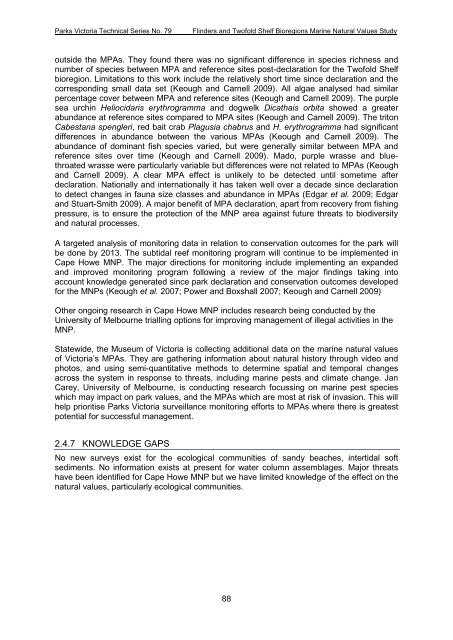parks victoria technical series marine natural values study vol 2 ...
parks victoria technical series marine natural values study vol 2 ...
parks victoria technical series marine natural values study vol 2 ...
You also want an ePaper? Increase the reach of your titles
YUMPU automatically turns print PDFs into web optimized ePapers that Google loves.
Parks Victoria Technical Series No. 79<br />
Flinders and Twofold Shelf Bioregions Marine Natural Values Study<br />
outside the MPAs. They found there was no significant difference in species richness and<br />
number of species between MPA and reference sites post-declaration for the Twofold Shelf<br />
bioregion. Limitations to this work include the relatively short time since declaration and the<br />
corresponding small data set (Keough and Carnell 2009). All algae analysed had similar<br />
percentage cover between MPA and reference sites (Keough and Carnell 2009). The purple<br />
sea urchin Heliocidaris erythrogramma and dogwelk Dicathais orbita showed a greater<br />
abundance at reference sites compared to MPA sites (Keough and Carnell 2009). The triton<br />
Cabestana spengleri, red bait crab Plagusia chabrus and H. erythrogramma had significant<br />
differences in abundance between the various MPAs (Keough and Carnell 2009). The<br />
abundance of dominant fish species varied, but were generally similar between MPA and<br />
reference sites over time (Keough and Carnell 2009). Mado, purple wrasse and bluethroated<br />
wrasse were particularly variable but differences were not related to MPAs (Keough<br />
and Carnell 2009). A clear MPA effect is unlikely to be detected until sometime after<br />
declaration. Nationally and internationally it has taken well over a decade since declaration<br />
to detect changes in fauna size classes and abundance in MPAs (Edgar et al. 2009; Edgar<br />
and Stuart-Smith 2009). A major benefit of MPA declaration, apart from recovery from fishing<br />
pressure, is to ensure the protection of the MNP area against future threats to biodiversity<br />
and <strong>natural</strong> processes.<br />
A targeted analysis of monitoring data in relation to conservation outcomes for the park will<br />
be done by 2013. The subtidal reef monitoring program will continue to be implemented in<br />
Cape Howe MNP. The major directions for monitoring include implementing an expanded<br />
and improved monitoring program following a review of the major findings taking into<br />
account knowledge generated since park declaration and conservation outcomes developed<br />
for the MNPs (Keough et al. 2007; Power and Boxshall 2007; Keough and Carnell 2009)<br />
Other ongoing research in Cape Howe MNP includes research being conducted by the<br />
University of Melbourne trialling options for improving management of illegal activities in the<br />
MNP.<br />
Statewide, the Museum of Victoria is collecting additional data on the <strong>marine</strong> <strong>natural</strong> <strong>values</strong><br />
of Victoria’s MPAs. They are gathering information about <strong>natural</strong> history through video and<br />
photos, and using semi-quantitative methods to determine spatial and temporal changes<br />
across the system in response to threats, including <strong>marine</strong> pests and climate change. Jan<br />
Carey, University of Melbourne, is conducting research focussing on <strong>marine</strong> pest species<br />
which may impact on park <strong>values</strong>, and the MPAs which are most at risk of invasion. This will<br />
help prioritise Parks Victoria surveillance monitoring efforts to MPAs where there is greatest<br />
potential for successful management.<br />
2.4.7 KNOWLEDGE GAPS<br />
No new surveys exist for the ecological communities of sandy beaches, intertidal soft<br />
sediments. No information exists at present for water column assemblages. Major threats<br />
have been identified for Cape Howe MNP but we have limited knowledge of the effect on the<br />
<strong>natural</strong> <strong>values</strong>, particularly ecological communities.<br />
88

















